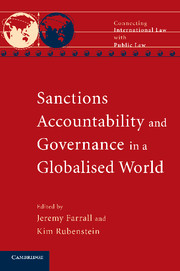Book contents
- Frontmatter
- Contents
- Contributors
- Series editors' preface
- Editors' preface
- Introduction: Filling or falling between the cracks? Law's potential
- PART I Setting down the foundations
- PART II Internationalising public law
- PART III Implementing Security Council sanctions
- PART IV The place of corporations
- 9 The nexus between human rights and business: Defining the sphere of corporate responsibility
- 10 At the intersection of international and municipal law: The case of Commissioner Cole and the Wheat Export Authority
- PART V The role of lawyers
- PART VI Public law and public policy
- PART VII Parallel case studies
- Concluding remarks
- Bibliography
- Index
9 - The nexus between human rights and business: Defining the sphere of corporate responsibility
Published online by Cambridge University Press: 05 October 2010
- Frontmatter
- Contents
- Contributors
- Series editors' preface
- Editors' preface
- Introduction: Filling or falling between the cracks? Law's potential
- PART I Setting down the foundations
- PART II Internationalising public law
- PART III Implementing Security Council sanctions
- PART IV The place of corporations
- 9 The nexus between human rights and business: Defining the sphere of corporate responsibility
- 10 At the intersection of international and municipal law: The case of Commissioner Cole and the Wheat Export Authority
- PART V The role of lawyers
- PART VI Public law and public policy
- PART VII Parallel case studies
- Concluding remarks
- Bibliography
- Index
Summary
Introduction
It is no longer a revelation that companies have some responsibility to uphold human rights. The interesting questions concern which rights and to what extent. In 2005, the then United Nations Commission on Human Rights put the issue of corporate responsibility front and centre when it adopted a resolution requesting the Secretary-General to appoint a Special Representative on the issue of human rights and transnational corporations and other business enterprises (SRSG). The appointment of Professor John Ruggie to this position in July 2005 signalled a strategic re-engagement by the UN with the ongoing struggle to marry human rights with business. Recognition of the relationship between business and human rights is one thing, delineating its boundaries is another. In seeking an answer to the recurring question of how, in practice, can corporate compliance with international human rights standards be improved, one must begin by clarifying the boundaries of corporate responsibility for human rights. What is it we are asking corporations to assume responsibility for and how far does that responsibility extend?
The mandate of the SRSG on business and human rights recognises a variety of attempts that have been employed to apply human rights standards to corporations. The mandate seeks identification and clarification of the standards of corporate responsibility and accountability including the nebulous concept of a corporation's ‘sphere of influence’: a non- (or perhaps pre-) legal concept that is being increasingly used to attempt to place practical limits on corporate accountability for human rights.
- Type
- Chapter
- Information
- Sanctions, Accountability and Governance in a Globalised World , pp. 217 - 238Publisher: Cambridge University PressPrint publication year: 2009



